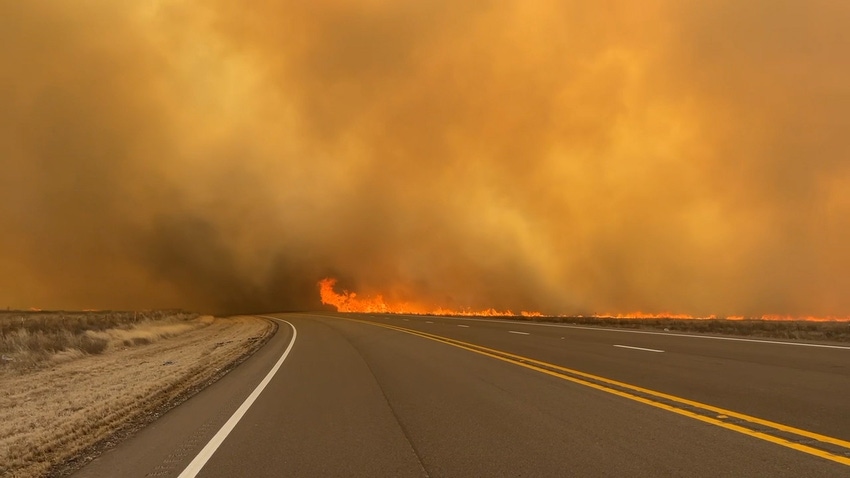
Andy Holloway, Hemphill County Texas AgriLife Extension agent, estimates that some 400,000 to 450,000 acres of rangeland has burned in the county.
That’s about half the 1,076,638 acres burning in the Smokehouse Creek fire, the largest wildfire in Texas history.
Estimates of lost cattle remain uncertain, Holloway said from the County Extension office in Canadian, “but losses will be high. I met with local veterinarians this morning (March 4) and they estimate from 5,000 to 10,000 head will be lost.
“We also have 52 homes destroyed and 115 or more outbuildings, including barns, garages, and sheds, destroyed. The hundreds or thousands of miles of fences destroyed is incomprehensible.”
Holloway said cropland losses are insignificant. “We don’t have much cropland on this side of the Panhandle.”
On the other side of the coin, Hollway added, is the kindness of the American people. “They are showing up in Canadian, with a lot of hay, cattle cubes and feed, and supplies to meet human needs, water and things of that nature.”
Financial needs
Holloway encouraged folks not to send clothes. “We don’t need those. We do need financial donations, money that will be spent locally to go directly to ranchers who will have to rebuild water resources, fencing, infrastructure, all kinds of things that probably will take years to replace, if that’s even possible.”
He says on a more positive note, “No one is fighting the large fires here now. We have little pop-up fires showing up here, there, and yonder. There are still some hot spots, but we don't have firefighters out fighting a big wildfire anymore. The fire department might get called out to put out a fire, but so much has burned up there's not much left to burn.
“It’s still a tinderbox, however, and the county right to the north of us, Lipscomb County, was mostly untouched, and they have as much standing grass and potential to burn as we had before this fire. So, we have to take care of these little hotspots because we don't want our neighbors to burn up.”
Holloway says anyone who wants to donate money should send checks to the Canadian Volunteer Fire Department, through a 5013C account.
“Make checks out to the Canadian Volunteer Fire Department, P.O. Box 300, Canadian, Texas, 70194. In the memo space write ‘Rancher Wildfire Fund.’
“For folks who want to donate hay or fencing supplies, the Hemphill County Livestock Supply Point is Canadian A H and N, our local feed store. It’s located at 100 Hackberry Street, Canadian, Texas.” Folks should call (806) 323-9921 to schedule hay or fencing supply deliveries.
Conditions Improving
Potential for containment of the large fires is improving, said Terry Krasko, with the Southern Area Blue Team, a management group organized by the U.S. Forest Service to assist 13 southern states with disasters such as the Texas Panhandle fires.
“We are working with the Texas A&M Forest Service,” Krasko said. “We help out where needed.”
Krasko said weather conditions improved over the weekend. The wind direction changed from out of the Southwest to out of the North. “Wind speed has declined to 15 miles per hour. That’s still windy threat but less than we’ve seen over the last few days. A cold front moving in also improves control options.”
As of Monday morning, Krasko said the Smokehouse Creek fire, 1,076,638 acres, was 15% contained. The Windy Deuce fire, 144,206 acres, was 55% contained, and the Grape Vine Creek fire, 34,882 acres, was 60% contained.
Krasko said manpower and equipment devoted to the fire is significant. For Smokehouse Creek, 181 personnel, 8 engines, and 36 dozers are on site. Windy Dese has 209 personnel, 28 engines, and two dozers; Grape Vine Creek has 28 personnel and five engines.
“We also have aerial support from tankers, helicopters and other aircraft.”
Looking ahead
Monty Dozier, program director, Texas A&M AgriLife Disaster Assessment and Recovery, says the biggest issue ranchers face in the coming weeks will be loss of grazing potential. “Last spring the Texas Panhandle was wetter than normal, the greenest I had seen in my life and I grew up in that area. The region produced a lot of grass last summer. They have now lost that grass and a lot of grazing potential. The need for hay is significant, as well as protein supplement and cubes.”
“Fencing material is one of the biggest needs in the impact zone so ranchers can begin building back,” Dozier said. “Second biggest need would be hay.”
Relocating cattle
He says some ranchers will have to relocate all or part of their herds. “They are looking for places to put their cattle. This is a large impact zone, so some producers might have to travel many miles to find suitable pasture.
Possibilities include South Central Texas, Oklahoma, and Kansas.
“A&M will focus on animal recovery,” Dozier added. The effect on the herd in the area will be significant and long-term.
Grassland recovery is dependent on spring rains and patience. “We want grass to establish and build a strong root system before grazing,” Dozier said. “Also, the ground is now exposed, so erosion could be an issue.”
Recovery time for grazing is hard to predict, Dozier said. “We have rangeland specialists looking into it. We have active fire response teams in place now and then we shift to recovery and long-term recovery.”
He agrees with Holloway that disaster sometimes brings out the best in people. “It is heartwarming to see so many people wanting to help. We get responses from folks 5 miles and 500 miles away. From Texas and other states, producers help each other.”
About the Author(s)
You May Also Like






